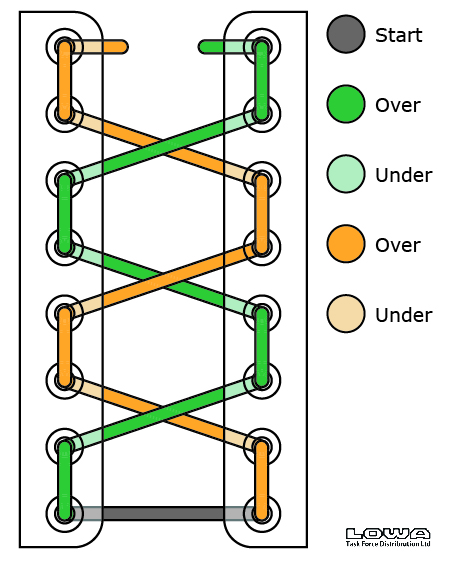There are a number of tried and tested ways to lace LOWA military boots, and while aesthetic qualities may be a factor, many have purpose-driven benefits too. To demonstrate this, below are 5 popular ways to lace LOWA Military and Tactical Boots.
Popular Military & Tactical Boot lacing Configurations
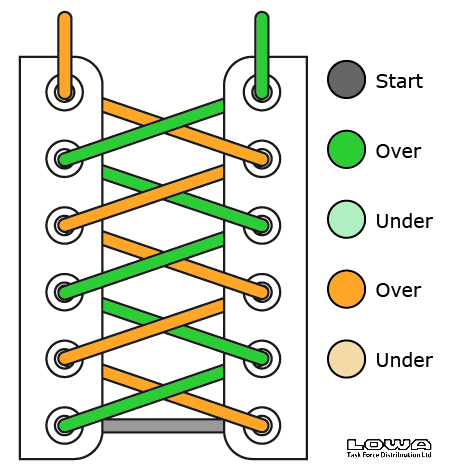 Criss-Cross Lacing
Criss-Cross Lacing
Holding the title of the most common lacing method, Criss-Cross lacing can be seen in footwear displays across most shoe and boot stores around the world. This is because the Criss-Cross lacing method is defined by its simplicity and ease of application, regardless of the number of eyelets along the boot. Begin by feeding the lace through the bottom eyelets, with the lace coming from inside towards the outside on both sides. Next, at each eyelet pair, cross the ends of the lace as you run them diagonally up and through the next set of eyelets, again feeding the lace from the inside towards the outside. Keep doing this until you’ve filled the desired number of eyelets.
Straight-Bar Lacing
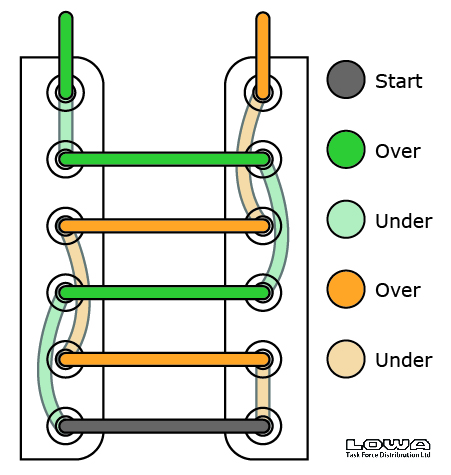 Also known as ‘Lydiard Lacing’ or ‘Fashion Lacing’, this style differs from criss-cross lacing by having no diagonal crossings from eyelet to eyelet. In addition to looking neater, this variation of Straight Lacing will relieve pressure on the top ridge of the foot. It’s important to note that this style only works on an even number of eyelets. Begin by facing the lace through the bottom eyelets from the outside in, then run the left side of the lace to the eyelet straight above and feed it back out again. This end is to be fed directly across the shoe to go into the opposite eyelet, once again from the outside going in. Because now both of the eyelets second from the bottom will be taken by the left starting end of the bootlace, the right end will skip this row and be fed out through the eyelet that is the third from the bottom. This will result in the ends of the lace alternating over the rows of eyelets. Both ends should continue straight across on the outside and in through the adjacent eyelets. To complete the lacing, alternate running lace ends up on the inside and horizontally across on the outside until lacing is completed.
Also known as ‘Lydiard Lacing’ or ‘Fashion Lacing’, this style differs from criss-cross lacing by having no diagonal crossings from eyelet to eyelet. In addition to looking neater, this variation of Straight Lacing will relieve pressure on the top ridge of the foot. It’s important to note that this style only works on an even number of eyelets. Begin by facing the lace through the bottom eyelets from the outside in, then run the left side of the lace to the eyelet straight above and feed it back out again. This end is to be fed directly across the shoe to go into the opposite eyelet, once again from the outside going in. Because now both of the eyelets second from the bottom will be taken by the left starting end of the bootlace, the right end will skip this row and be fed out through the eyelet that is the third from the bottom. This will result in the ends of the lace alternating over the rows of eyelets. Both ends should continue straight across on the outside and in through the adjacent eyelets. To complete the lacing, alternate running lace ends up on the inside and horizontally across on the outside until lacing is completed.
Ladder Lacing
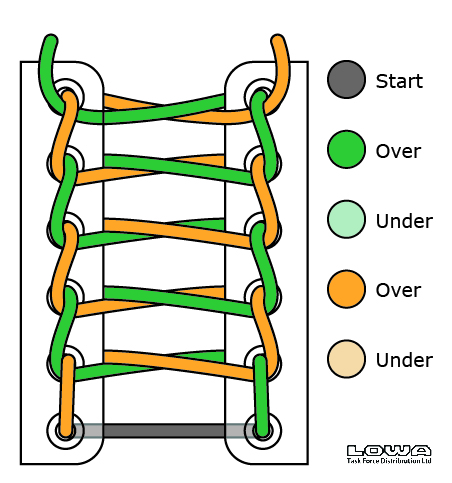 This style of Military Boot lacing can be seen worn by paratroopers and ceremonial guard units as it lends more stability and support than the Straight-Bar and Criss Cross methods. This visually distinctive style requires long laces and tends to work best on tall tactical boots with many eyelets, for example, the LOWA Urban Military 2 Boots. Begin once again with the bootlace going straight across the bottom eyelets from the inside and feeding towards the outside in the same way as with the Criss Cross method. The second step is to run both ends of the lace straight up to the eyelet directly above and feed each end through from the outside in. Now the lace-ends should go straight across horizontally, crossing each other along the way to be fed underneath the vertical lace that was created through the second step. Feeding a lace-end underneath the previous section of lace which travels up from the first to the second eyelet will allow it to be held in that place as if it was going through an eyelet. Now that end should be brought up to the next eyelet directly above in the same way as in step two, in order to be fed through the next eyelet up from the outside in and repeat the process until lacing is done.
This style of Military Boot lacing can be seen worn by paratroopers and ceremonial guard units as it lends more stability and support than the Straight-Bar and Criss Cross methods. This visually distinctive style requires long laces and tends to work best on tall tactical boots with many eyelets, for example, the LOWA Urban Military 2 Boots. Begin once again with the bootlace going straight across the bottom eyelets from the inside and feeding towards the outside in the same way as with the Criss Cross method. The second step is to run both ends of the lace straight up to the eyelet directly above and feed each end through from the outside in. Now the lace-ends should go straight across horizontally, crossing each other along the way to be fed underneath the vertical lace that was created through the second step. Feeding a lace-end underneath the previous section of lace which travels up from the first to the second eyelet will allow it to be held in that place as if it was going through an eyelet. Now that end should be brought up to the next eyelet directly above in the same way as in step two, in order to be fed through the next eyelet up from the outside in and repeat the process until lacing is done.
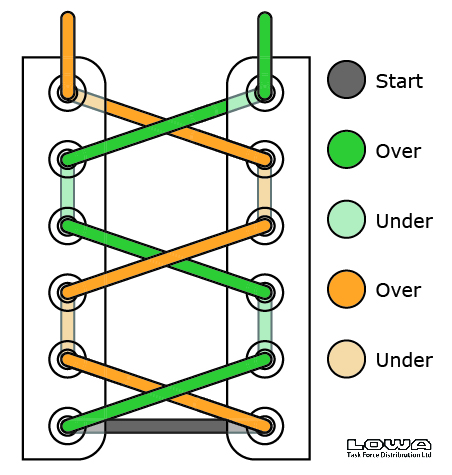 Bow Tie Lacing
Bow Tie Lacing
The Bow Tie method is very simple and consumes the least amount of shoelace, leaving as much length on either end of the lace-free for tying the final knot. This lacing process earns its name from the bow tie shape formed along four pairs of eyelets, resulting from crossing the laces diagonally over the middle two (of the four) eyelets, and horizontally across on outer two eyelets. For boots with an even number of eyelet pairs, begin with the lace straight across on the outside and in through the bottom eyelets, and for odd-numbered eyelet pairs, start on the inside going out. Run each side up to the eyelet directly above and feed it through, followed by running it across to the other side, diagonally up to the next row up and feed through that eyelet. Do this for both sides, then repeat the process.
Army Lacing
Finally, we’ll address this variation on Bow Tie lacing which has been employed by militaries across the world. Military and Tactical Boots are made with thick materials and usually very sturdy. While providing much support, the thick leather can make the experience hard and uncomfortable, especially for boots that have not been worn in. Army Lacing loosens up the leather of a boot on either side for a more flexible fit. Knowing the Bow Tie technique makes this one very simple to explain as there is only one difference. This is that the horizontal and diagonal crossovers are on the insides and the vertical sections are on the outside. The ‘inside-out’ version of the Bow Tie if you will. This means that you reverse the rule of inside-outside lacing between odd and even strings.
***********************************************
Each lacing technique comes with its own purpose. For instance, the ladder lacing method is more suitable than army lacing if you require greater rigidity; such as for marching, parachuting or greater ankle support.
As far as we're concerned, all of these lace configurations are perfectly suitable for LOWA Boots. Whichever one you choose, it's important to tie your boots up in a kneeling down position so that the shin of the leg is at the front of the boot you are lacing up. This effectively ensures the foot is correctly positioned within the boot and that not too much pressure is added to the laces, as this would increase the risk of shin splints and stress fractures of the lower limbs. Of course, there are design features integrated into LOWA boots that reduce this risk and assist with lacing, but it's better to be safe than sorry and important to cultivate good habits.

